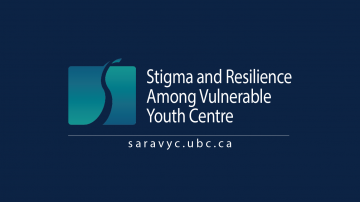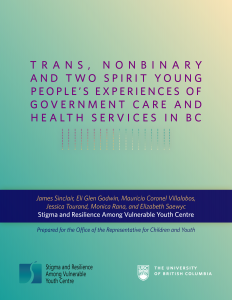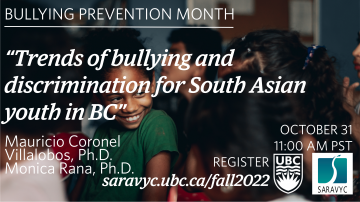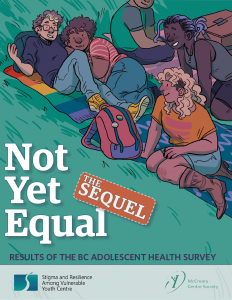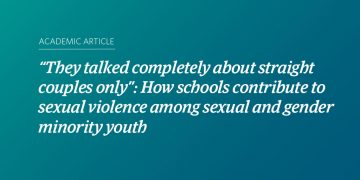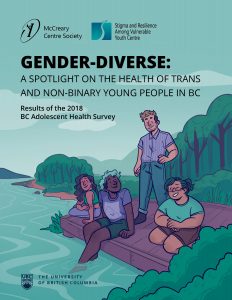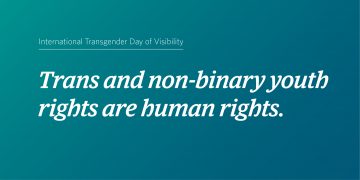2SLGBTQ+ inclusive education initiatives are essential to fostering safe school environments for all youth–not just 2SLGBTQ+ youth
As the current researchers evaluating SOGI 1 2 3, the Stigma and Resilience Among Vulnerable Youth Centre (SARAVYC) would like to express our support for educational programs that make schools safer for 2SLGBTQ+ children. These programs are vital for the well-being and safety of all children and, to quote the BC Human Rights Commissioner Kasari Govender, “the human rights of LGBTQ2SAI+ people are not up for debate.”
Report Launch: Representative for Children and Youth release The Right to Thrive: An Urgent Call to Recognize, Respect and Nurture Two Spirit, Trans, Non-Binary and other Gender Diverse Children and Youth
In Representative Charlesworth’s own words, “Let’s be clear: young people have the right to be who they are and to thrive…The hate speech and anti-trans legislative efforts we have seen recently in Canada and the United States is alarming and is causing great harm.
The Right to Thrive: An Urgent Call to Recognize, Respect and Nurture Two Spirit, Trans, Non-Binary and other Gender Diverse Children and Youth from the Representative for Children and Youth
In Representative Charlesworth’s own words, “Let’s be clear: young people have the right to be who they are and to thrive…The hate speech and anti-trans legislative efforts we have seen recently in Canada and the United States is alarming and is causing great harm.
Priority indicators for adolescent health measurement – recommendations from the Global Action for Measurement of Adolescent Health (GAMA) advisory group.
Abstract Purpose: This article describes the selection of priority indicators for adolescent (10–19 years) health measurement proposed by the Global Action for Measurement of Adolescent health advisory group and partners, building on previous work identifying 33 core measurement areas and mapping 413 indicators across these areas. Methods: The indicator selection process considered inputs from a broad range […]
Youth characteristics associated with sexual violence perpetration among transgender boys and girls, cisgender boys and girls, and non-binary youth.
Abstract Importance: Gender minority adults experience higher rates of sexual violence (SV) thancisgender adults. How this disparity extends to youths, including perpetration rates, is unknown. Objective: To compare rates of experience and perpetration of SV by gender identity andinvestigate characteristics associated with odds of perpetration within gender identity categories. Design, Setting, and Participants: This cross-sectional study […]
Fall 2022 Lecture Series
Join us for our fall lecture series, a three part webinar selection on our current and past research at SARAVYC. We will cover topics including bullying and its prevention, trans issues, and youth human rights.
Not Yet Equal (the Sequel): Results of the BC Adolescent Health Survey
Not Yet Equal (the Sequel): Results of the BC Adolescent Health Survey provides a profile of the health LGBTQ youth in British Columbia (BC). The report is a collaboration between researchers at SARAVYC and the McCreary Centre Society and uses data from the 2018 BC Adolescent Health Survey (BC AHS), which is one of the […]
“They talked completely about straight couples only”: How schools contribute to sexual violence among sexual and gender minority youth
This study examined contextual factors shaping sexual violence victimisation and perpetration among sexual and gender minority youth, with school playing a key role. Based on qualitative data from semi-structured interviews with 50 young people aged 14–26 years who self-reported sexual violence perpetration in the Growing Up with Media survey, the analysis demonstrates how schooling’s ‘hidden curriculum’ leaves sexual and gender minority youth ill-equipped to navigate the world of sexuality.
Trans and non-binary youth rights are human rights
International Transgender Day of Visibility is a day to celebrate trans folks and raise awareness about the discrimination and violence that targets them. On Transgender Day of Remembrance, we shared some of the challenges trans and non-binary youth are faced with. Today, we’d like to share some of the ways that trans and non-binary youth feel supported.
